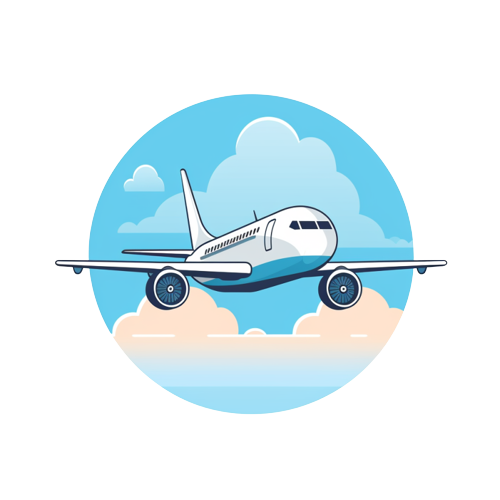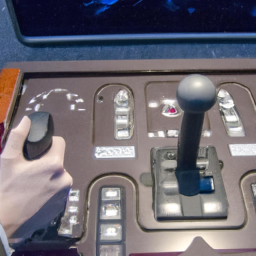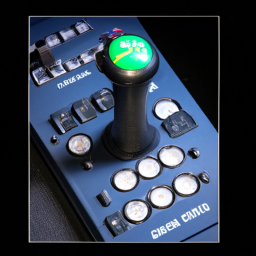In this article, we will explore the essential skills you need to master in order to become proficient at flight simulation. You will learn about the importance of understanding the basics of aviation and navigation, as well as the need for effective communication and decision-making skills. Additionally, we will discuss the significance of hand-eye coordination and situational awareness in this virtual training environment. By the end of this article, you will have a better understanding of the key skills necessary to excel in flight simulation.
Understanding the Basics of Flight Simulation
Flight simulation is a fascinating and dynamic field that allows individuals to experience the thrill and challenge of flying without leaving the ground. Whether you aspire to become a professional pilot or simply have a passion for aviation, mastering the key skills required for flight simulation is crucial. In this article, we will explore the essential skills needed to excel in flight simulation, guiding you towards becoming a proficient virtual aviator.
Learn about the different types of flight simulators
Before delving into the specifics of flight simulation, it is vital to familiarize yourself with the different types of simulators available. From basic desktop setups to full-motion simulators used by professional pilots, there is a wide range of options to choose from. Take the time to research and understand the features, capabilities, and limitations of each type of simulator, and determine which one suits your needs and goals best.
Familiarize yourself with the components of a flight simulator
Once you have chosen a flight simulator, it is essential to become familiar with its components. A typical flight simulator setup includes a computer, flight controls (such as a joystick or yoke), pedals, and multiple monitors or virtual reality headsets. Understanding how each component works and how to configure them correctly is crucial for a smooth and immersive simulation experience.
Understand the basic principles of flight simulation
Flight simulation is based on the principles of aerodynamics and employs realistic flight models to simulate the behavior of aircraft. To become proficient at flight simulation, it is important to have a basic understanding of aerodynamics, including principles such as lift, drag, and thrust. Familiarize yourself with the basic concepts of flight dynamics and how they relate to the control inputs you make in the simulator.
Developing a Solid Foundation in Aviation Knowledge
Building a solid foundation in aviation knowledge is essential for mastering flight simulation. While you may not physically be in an aircraft, understanding the principles and procedures of real-world aviation will greatly enhance your virtual flying experience.
Study the basic principles of aerodynamics
A fundamental understanding of aerodynamics is key to grasping the complexities of flight simulation. Learn about the four forces of flight – lift, weight, thrust, and drag – and how they interact to keep an aircraft aloft. Study the factors that affect aircraft performance, such as angle of attack, air density, and airfoil design.
Learn about flight controls and instrumentation
Flight controls and instrumentation play a crucial role in aircraft handling and operation. Understanding the different control surfaces, such as the ailerons, elevator, and rudder, and how they affect the aircraft’s motion is essential for successful flight simulation. Additionally, familiarize yourself with the primary flight instruments, such as the altimeter, airspeed indicator, and attitude indicator, as they provide important information about the aircraft’s flight parameters.
Gain knowledge of aircraft systems and procedures
Aircraft systems form the backbone of flight operations, and having a thorough understanding of them is essential for a realistic simulation experience. Learn about the various systems that make an aircraft function, including the electrical, hydraulic, and fuel systems. In addition, familiarize yourself with standard operating procedures related to pre-flight checks, engine startup, takeoff, cruise, descent, and landing.
Building Proficiency in Aircraft Handling
Mastering the art of aircraft handling is a crucial skill for any flight simulator enthusiast. Whether you are practicing basic maneuvers or navigating complex flight scenarios, honing your aircraft handling skills is a continual process.
Practice basic maneuvers such as takeoff and landing
Begin by practicing essential maneuvers such as takeoff and landing. Become accustomed to the necessary control inputs required to smoothly and safely lift off from the runway and make a precise touchdown. Pay attention to factors like runway alignment, airspeed management, and aircraft configuration during these maneuvers.
Master aircraft control during different flight phases
As you progress in your flight simulation journey, focus on improving your aircraft control skills during different flight phases, including climb, cruise, and descent. Learn how to adjust power settings, maintain a steady altitude, and control airspeed to achieve a smooth and efficient flight profile.
Learn to control aircraft in various weather conditions
Flight simulation allows you to experience a range of weather conditions, from clear skies to turbulent storms. Learning to control an aircraft in adverse weather conditions is essential for becoming proficient in flight simulation. Practice flying in crosswinds, rain, snow, and low visibility to enhance your aircraft handling skills in challenging environments.
Mastering Navigation and Instrumentation
Navigating through the skies is a fundamental aspect of aviation, and mastering navigation and instrumentation skills is crucial for a realistic flight simulation experience.
Understand navigation principles and techniques
Navigating an aircraft requires a solid understanding of navigation principles and techniques. Learn about different navigation systems, such as VOR (VHF Omni-directional Range) and GPS (Global Positioning System), and how to interpret navigation charts and instruments. Practice plotting routes, calculating headings, and estimating fuel consumption to enhance your navigation skills.
Become proficient in using flight instruments
Flight instruments provide critical information about an aircraft’s performance and position. Take the time to understand the functions and indications of key flight instruments, such as the heading indicator, vertical speed indicator, and turn coordinator. Regularly practice instrument scans to ensure you are proficient in reading and interpreting instrument information during flight simulation.
Learn to interpret and follow aviation charts and maps
Aviation charts and maps are essential tools for pilots, both in the real world and in flight simulation. Familiarize yourself with the different types of charts, such as sectional charts and approach plates, and understand how to interpret symbols, colors, and annotations. Practice planning and following routes using charts and maps to develop your navigation skills.
Developing Effective Decision-Making Skills
Flight simulation provides an excellent platform for developing and honing effective decision-making skills, a critical aspect of real-world aviation.
Develop situational awareness during flight simulation
Situational awareness refers to the ability to perceive and understand the current situation and make informed decisions based on that understanding. In flight simulation, constantly assess your surroundings, monitor aircraft performance, and anticipate potential challenges or risks. Develop the habit of scanning external and internal cues to maintain a high level of situational awareness.
Practice making quick and sound decisions
Flight simulations often present fast-paced scenarios that demand quick decision-making. Practice making prompt yet well-informed decisions, considering factors such as weather conditions, air traffic, and system malfunctions. Regular exposure to critical decision-making scenarios will enhance your ability to think on your feet during flight simulation.
Learn to prioritize and manage tasks in a simulated flight environment
Effective task management is essential in aviation, where multiple tasks must be performed simultaneously. Develop the ability to prioritize tasks based on their importance and time sensitivity. Practice multitasking during flight simulation, focusing on maintaining aircraft control while managing navigation, communication, and system checks.
Enhancing Communication and Collaboration Skills
Real-world aviation involves seamless communication and collaboration between pilots, air traffic control, and other flight crew members. Developing effective communication and collaboration skills will vastly improve your flight simulation experience.
Improve radio communication skills with air traffic control
Flight simulation software often includes simulated air traffic control (ATC) communication. Learn the standard phraseology and procedures used in radio communications and emulate real-world interactions with simulated ATC. Practice listening carefully, following instructions accurately, and effectively communicating your intentions to ATC.
Learn to effectively communicate with co-pilots or virtual passengers
In certain flight simulation scenarios, you may be accompanied by virtual co-pilots or passengers. Learn how to effectively communicate and delegate tasks to co-pilots, fostering a sense of teamwork and cooperation. Additionally, practice providing clear and concise instructions or information to virtual passengers, enhancing their virtual flying experience.
Understand the importance of teamwork and coordination
Aviation is a team effort, and flight simulation is no exception. Understand the importance of teamwork and coordination, even in a virtual environment. Collaborate with other virtual aviators, participate in online flying events, and engage with virtual pilot communities to foster a sense of camaraderie and collective learning.
Managing System Failures and Emergencies
Simulated system failures and emergencies are valuable learning opportunities for developing critical thinking and problem-solving skills.
Learn to handle system failures and emergency situations
Simulated system failures and emergencies can range from simple malfunctions to complex scenarios. Study emergency procedures for various aircraft systems, such as engine failures or electrical problems. Practice responding to simulated emergencies, applying appropriate checklists and procedures to safely resolve the situation.
Practice emergency procedures and troubleshooting
Developing proficiency in emergency procedures and troubleshooting is crucial for effective aircraft handling. Regularly practice emergency scenarios, focusing on your ability to diagnose issues, apply appropriate procedures, and troubleshoot in real-time. These simulations will simulate the pressure and urgency of real-world emergencies, allowing you to develop confidence and competence in critical situations.
Develop the ability to remain calm and make critical decisions under pressure
Maintaining a calm and composed demeanor under pressure is vital in aviation. Flight simulations provide an opportunity to practice managing stress and making critical decisions when faced with emergencies. Focus on maintaining a clear thought process, prioritizing tasks, and remaining calm even in challenging or high-stress scenarios.
Utilizing Flight Planning and Simulation Software
Flight planning and simulation software can greatly enhance your flight simulation experience, providing realistic scenarios and tools to refine your skills.
Explore flight planning tools and software
Flight planning software allows you to plan routes, calculate fuel requirements, and determine important flight parameters automatically. Explore different flight planning tools and software available, experiment with route planning, and utilize the features that best suit your needs. Effective flight planning will enhance your situational awareness and help you execute flights efficiently.
Learn to create and execute flight plans
Understanding the process of creating and executing flight plans is essential for a realistic flight simulation experience. Practice creating flight plans, ensuring accurate waypoint selection, and proper route implementation. Regularly simulate flights based on your plans, evaluating their accuracy and efficiency.
Utilize realistic flight simulation software to enhance proficiency
Realistic flight simulation software, such as Microsoft Flight Simulator or X-Plane, provides an immersive environment for developing and refining your skills. Utilize these platforms to practice various flight scenarios, explore different aircraft types, and simulate real-world situations. Take advantage of the detailed weather, air traffic, and airport simulations offered by these software programs to enhance your overall proficiency.
Engaging in Continuous Learning and Practice
To become truly proficient at flight simulation, engagement in continuous learning and practice is essential.
Stay updated with the latest aviation regulations and procedures
Aviation regulations and procedures are constantly evolving, and it is crucial to stay updated with the latest developments. Regularly review aviation publications, websites, and forums to stay informed about changes in procedures, technology, and regulations. This continuous learning will ensure that your flight simulation practices align with real-world aviation standards.
Participate in virtual pilot communities and forums
Engaging with virtual pilot communities and forums provides an excellent platform for sharing knowledge, experiences, and tips with fellow enthusiasts. Participate in discussions, ask questions, and contribute to the community’s collective knowledge base. Virtual pilot communities can provide valuable insights, advice, and troubleshooting assistance that can greatly enhance your flight simulation skills.
Regularly practice flight simulation to maintain and improve skills
Consistency is key in developing proficiency in flight simulation. Set aside dedicated time for regular practice sessions to maintain and improve your skills. Simulate a variety of flight scenarios, challenge yourself with different aircraft types and weather conditions, and set goals to continually push yourself further. With each practice session, you will gain confidence and refine your skills, ultimately becoming a proficient virtual aviator.
Conclusion
Mastering the key skills required for flight simulation is a rewarding journey that offers an array of benefits. By understanding the basics of flight simulation, building a solid foundation in aviation knowledge, and continuously learning and practicing, you can become proficient at flight simulation. The ability to handle various flight maneuvers, navigate accurately, make critical decisions, communicate effectively, manage emergencies, and utilize flight planning and simulation software will empower you to experience the joys of aviation from the comfort of your own home. Embark on this exciting adventure, explore the possibilities, and immerse yourself in the world of flight simulation. The sky’s the limit!




